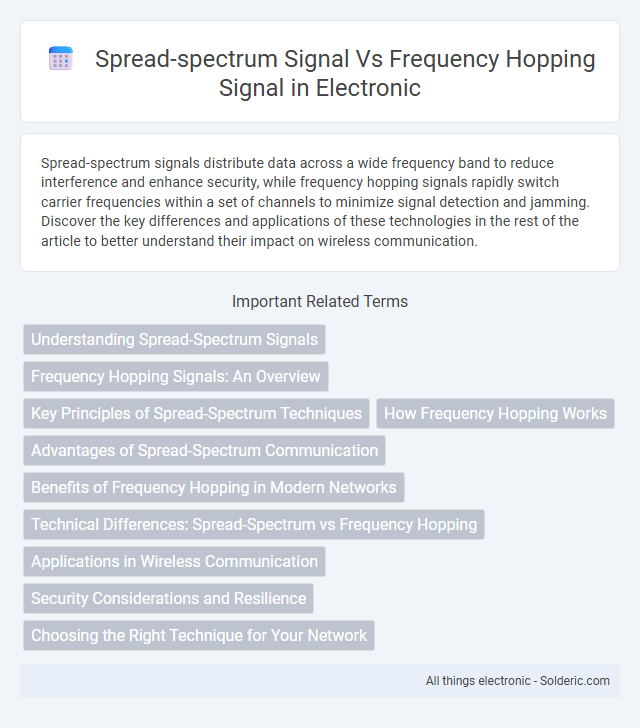Spread-spectrum signals distribute data across a wide frequency band to reduce interference and enhance security, while frequency hopping signals rapidly switch carrier frequencies within a set of channels to minimize signal detection and jamming. Discover the key differences and applications of these technologies in the rest of the article to better understand their impact on wireless communication.
Comparison Table
| Feature | Spread-Spectrum Signal | Frequency Hopping Signal |
|---|---|---|
| Definition | Signal dispersed across a wide frequency band simultaneously | Signal rapidly switches frequencies within a band in a sequence |
| Type | Direct Sequence Spread Spectrum (DSSS), others | Frequency Hopping Spread Spectrum (FHSS) |
| Bandwidth Usage | Wide bandwidth used continuously | Narrow bandwidth used, switching frequencies over time |
| Interference Resistance | High resistance due to wideband signal | Good resistance by avoiding jammed frequencies |
| Security | Moderate, relies on spreading code secrecy | High, frequency changes harder to intercept |
| Synchronization | Requires chip-level synchronization | Requires timing coordination for hopping sequence |
| Typical Applications | GPS, CDMA mobile communication | Bluetooth, military radios |
| Power Consumption | Generally higher due to continuous wideband transmission | Lower, since using narrowband at each hop |
Understanding Spread-Spectrum Signals
Spread-spectrum signals distribute transmitted data across a wide frequency band to enhance resistance to interference, noise, and eavesdropping. Frequency hopping signals, a type of spread-spectrum, rapidly switch carrier frequencies in a pseudo-random sequence, improving security and minimizing signal jamming. Understanding these techniques helps you optimize wireless communication systems for reliability and secure data transmission.
Frequency Hopping Signals: An Overview
Frequency hopping signals rapidly switch carrier frequencies among multiple channels according to a pseudorandom sequence, enhancing resistance to interference and eavesdropping. This technique improves communication security and robustness in wireless systems by minimizing the effect of narrowband jamming and multipath fading. Frequency hopping is commonly used in military communications and Bluetooth technology to maintain reliable and secure transmissions.
Key Principles of Spread-Spectrum Techniques
Spread-spectrum techniques disperse a signal over a wide frequency band, enhancing resistance to interference and eavesdropping. Frequency hopping spread spectrum (FHSS) transmits by rapidly switching carriers among many frequency channels according to a pseudorandom sequence, improving signal robustness and security. Direct sequence spread spectrum (DSSS) spreads the signal by multiplying data with a high-rate pseudorandom code, increasing signal-to-noise ratio and minimizing jamming effects.
How Frequency Hopping Works
Frequency hopping signal transmits data by rapidly switching carrier frequencies within a predetermined hopping sequence, reducing interference and enhancing security. The transmitter and receiver synchronize their frequency changes using a shared pseudorandom sequence, allowing seamless communication over multiple frequency bands. This method improves resistance to jamming and interception compared to fixed-frequency spread-spectrum signals.
Advantages of Spread-Spectrum Communication
Spread-spectrum communication offers enhanced resistance to interference and jamming by distributing the signal over a wide frequency range, improving signal security and reducing the likelihood of interception. Its ability to minimize multipath fading and signal degradation in cluttered environments makes it ideal for military and wireless communication systems. Frequency hopping, a subset of spread-spectrum techniques, provides rapid switching between frequencies to avoid interference, but broader spread-spectrum methods deliver superior robustness and signal reliability.
Benefits of Frequency Hopping in Modern Networks
Frequency hopping signals enhance network security and resistance to interference by continually changing frequencies within a wide band, making unauthorized interception and jamming difficult. This method improves signal robustness and reduces multipath fading, ensuring more reliable communication in crowded or hostile environments. Your modern network benefits from frequency hopping's ability to maintain stable connections and optimize bandwidth usage in dynamic wireless conditions.
Technical Differences: Spread-Spectrum vs Frequency Hopping
Spread-spectrum signals distribute the transmitted information over a wide frequency band, improving resistance to interference and eavesdropping by making the signal appear as noise. Frequency hopping signals, a subset of spread-spectrum techniques, rapidly switch the carrier frequency among many discrete frequencies in a pseudo-random sequence, enhancing security and reducing the chance of interception or jamming. Understanding these technical differences helps optimize your communication system's performance and security against signal degradation and unauthorized access.
Applications in Wireless Communication
Spread-spectrum and frequency hopping signals are both crucial in wireless communication for enhancing security, reducing interference, and improving signal reliability. Spread-spectrum techniques, such as Direct Sequence Spread Spectrum (DSSS), are widely used in applications like GPS, Wi-Fi, and military communications to provide resistance against jamming and eavesdropping. Your choice of frequency hopping signals, often employed in Bluetooth and certain military radios, helps avoid interference by rapidly switching among multiple frequency channels, ensuring robust and secure connections in dynamic wireless environments.
Security Considerations and Resilience
Spread-spectrum signals enhance security by distributing the transmitted energy over a wide frequency band, making interception and jamming more difficult for adversaries. Frequency hopping signals improve resilience by rapidly switching frequencies according to a pseudorandom sequence, reducing vulnerability to narrowband interference and eavesdropping. Both techniques offer robust protection in secure communications, with frequency hopping providing superior resistance to intentional jamming and spread-spectrum ensuring signal concealment.
Choosing the Right Technique for Your Network
Spread-spectrum signals provide robust resistance to interference by distributing the signal across a wide frequency band, ideal for environments with high noise. Frequency hopping signals enhance security and minimize interference by rapidly switching frequencies in a pseudorandom sequence, making them suitable for secure communication networks. Selecting the right technique depends on network requirements such as interference tolerance, security needs, and available bandwidth.
spread-spectrum signal vs frequency hopping signal Infographic

 solderic.com
solderic.com